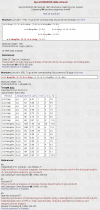Sharing of worldwide distributed carbohydrate-related digital resources: online connection of the Bacterial Carbohydrate Structure DataBase and GLYCOSCIENCES.de
- PMID: 17202164
- PMCID: PMC1899093
- DOI: 10.1093/nar/gkl883
Sharing of worldwide distributed carbohydrate-related digital resources: online connection of the Bacterial Carbohydrate Structure DataBase and GLYCOSCIENCES.de
Abstract
Functional glycomics, the scientific attempt to identify and assign functions to all glycan molecules synthesized by an organism, is an emerging field of science. In recent years, several databases have been started, all aiming to support deciphering the biological function of carbohydrates. However, diverse encoding and storage schemes are in use amongst these databases, significantly hampering the interchange of data. The mutual online access between the Bacterial Carbohydrate Structure DataBase (BCSDB) and the GLYCOSCIENCES.de portal, as a first reported attempt of a structure-based direct interconnection of two glyco-related databases is described. In this approach, users have to learn only one interface, will always have access to the latest data of both services, and will have the results of both searches presented in a consistent way. The establishment of this connection helped to find shortcomings and inconsistencies in the database design and functionality related to underlying data concepts and structural representations. For the maintenance of the databases, duplication of work can be easily avoided, and will hopefully lead to a better worldwide acceptance of both services within the community of glycoscienists. BCSDB is available at http://www.glyco.ac.ru/bcsdb/ and the GLYCOSCIENCES.de portal at http://www.glycosciences.de/.
Figures




Similar articles
-
GLYCOSCIENCES.de: an Internet portal to support glycomics and glycobiology research.Glycobiology. 2006 May;16(5):71R-81R. doi: 10.1093/glycob/cwj049. Epub 2005 Oct 20. Glycobiology. 2006. PMID: 16239495 Review.
-
GlycomeDB - integration of open-access carbohydrate structure databases.BMC Bioinformatics. 2008 Sep 19;9:384. doi: 10.1186/1471-2105-9-384. BMC Bioinformatics. 2008. PMID: 18803830 Free PMC article.
-
Bacterial carbohydrate structure database 3: principles and realization.J Chem Inf Model. 2011 Jan 24;51(1):159-70. doi: 10.1021/ci100150d. Epub 2010 Dec 14. J Chem Inf Model. 2011. PMID: 21155523
-
Glyco3D: a portal for structural glycosciences.Methods Mol Biol. 2015;1273:241-58. doi: 10.1007/978-1-4939-2343-4_18. Methods Mol Biol. 2015. PMID: 25753716
-
Using databases and web resources for glycomics research.Mol Cell Proteomics. 2013 Apr;12(4):1036-45. doi: 10.1074/mcp.R112.026252. Epub 2013 Jan 16. Mol Cell Proteomics. 2013. PMID: 23325765 Free PMC article. Review.
Cited by
-
PTM-SD: a database of structurally resolved and annotated posttranslational modifications in proteins.Database (Oxford). 2014 May 24;2014:bau041. doi: 10.1093/database/bau041. Print 2014. Database (Oxford). 2014. PMID: 24857970 Free PMC article.
-
Simple and practical sialoglycan encoding system reveals vast diversity in nature and identifies a universal sialoglycan-recognizing probe derived from AB5 toxin B subunits.Glycobiology. 2022 Nov 22;32(12):1101-1115. doi: 10.1093/glycob/cwac057. Glycobiology. 2022. PMID: 36048714 Free PMC article.
-
Bioinformatics and molecular modeling in glycobiology.Cell Mol Life Sci. 2010 Aug;67(16):2749-72. doi: 10.1007/s00018-010-0352-4. Epub 2010 Apr 4. Cell Mol Life Sci. 2010. PMID: 20364395 Free PMC article. Review.
-
Insights into Bioinformatic Applications for Glycosylation: Instigating an Awakening towards Applying Glycoinformatic Resources for Cancer Diagnosis and Therapy.Int J Mol Sci. 2020 Dec 8;21(24):9336. doi: 10.3390/ijms21249336. Int J Mol Sci. 2020. PMID: 33302373 Free PMC article. Review.
-
GlyTouCan: an accessible glycan structure repository.Glycobiology. 2017 Oct 1;27(10):915-919. doi: 10.1093/glycob/cwx066. Glycobiology. 2017. PMID: 28922742 Free PMC article.
References
-
- Lowe J., Marth J. A genetic approach to Mammalian glycan function. Annu. Rev. Biochem. 2003;72:643–691. - PubMed
-
- Raman R., Raguram S., Venkataraman G., Paulson J.C., Sasisekharan R. Glycomics: an integrated systems approach to structure-function relationships of glycans. Nature Methods. 2005;1:817–824. - PubMed
-
- von der Lieth C.W., Bohne-Lang A., Lohmann K.K., Frank M. Bioinformatics for glycomics: status, methods, requirements and perspectives. Brief Bioinformatics. 2004;5:164–178. - PubMed
-
- Harvey D. Proteomic analysis of glycosylation: structural determination of N- and O-linked glycans by mass spectrometry. Expert Rev. Proteomics. 2005;2:87–101. - PubMed
-
- Guerardel Y., Chang L., Maes E., Huang C., Khoo K. Glycomic survey mapping of zebrafish identifies unique sialylation pattern. Glycobiology. 2006;16:244–257. - PubMed
Publication types
MeSH terms
Substances
LinkOut - more resources
Full Text Sources
Other Literature Sources

